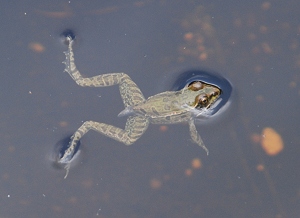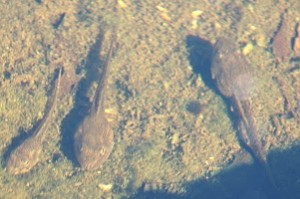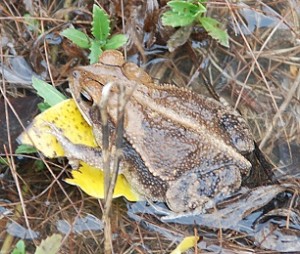 Young Rana berlandieri with last of its tail showing.
Young Rana berlandieri with last of its tail showing.
One of our wildlife management goals was to provide habitat for amphibians to reproduce. This required permanent water (no natural water on the place is permanent) with the right combination of water quality and vegetation. I have previously photographed these Rio Grande Leopard Frog tadpoles in the lily pond, but haven’t been able to photograph them in all stages.
 Leopard frog tadpoles in lily pond, 2005
Leopard frog tadpoles in lily pond, 2005
Last week, I saw quite a few whose hind legs were just showing, but could not get a good photo. They were “walking” a little on the bottom (we have two-foot-wide ledges about one foot deep on the sides of the lily pond) but still swam mostly with their tails. This afternoon, this fellow was lounging on the surface when I saw him, and stayed there long enough for me to get this picture. When the frog finally spooked, it kicked hard with both hind legs. The remaining tail now serves as a nutritional source–but not for much longer.
Because of our generally dry habitat, we don’t have many amphibian species here–one (or maybe two, especially in wet years) species of cricket frog, this leopard frog, in very wet years the occasional bullfrog (our pond is too small to offer enough food for bullfrogs for long) and the Gulf Coast Toad.
 Gulf Coast Toad, Bufo valliceps, in secondary drainage after rain
Gulf Coast Toad, Bufo valliceps, in secondary drainage after rain
Amphibian populations are declining world-wide for a number of reasons–they’re thought to be affected by climate change as well as loss of habitat and water pollution. We are very glad that our local populations have adapted to artificial supplemental water in the dry years, and that in wet years small populations surviving elsewhere return to the 80 acres.
The water garden that has proved successful for amphibian reproduction is replenished with collected rainwater from our roofs and planted with a mix of native and near-native (from wetter parts of the state) iris and water lilies to provide habitat for the aquatic species (not only amphibians but insects) and waterside animals (like the Red-lined Ribbon Snake featured last post.) These plants keep the water cleaner and cooler in summer as well as providing shelter and (for some species) food.
Comment by Steve Willson — May 24, 2010 @ 6:31 pm
That’s really a neat little frog. I’m glad to see that your efforts to provide suitable habitat are so successful. I also manage a dry site and have the challenge of providing the right conditions in which the local amphibians can prosper. Your success is an inspiration.
Comment by elizabeth — May 24, 2010 @ 10:51 pm
Thanks! It really is tricky, isn’t it? Esp in changing times. I wish we could put in a larger artificial system, but there just aren’t the water resources to do it. In the first year or two after we added the lily pond to the upper part, we had cricket frogs too, but as the system matured, the others out-competed them in this resource. I don’t know if it was the arrival of other predators, like the snakes (we’ve had visits by other species of aquatic snake) or simply that the larger pond attracted more leopard frogs and toads or….something else.
Your blog is fascinating…I looked it up just now and could happily spend hours reading the older entries.
Comment by Steve Willson — May 25, 2010 @ 8:24 am
Thanks, Elizabeth. My water garden went through a lot of changes the first few years. Year one was dominated by toads and several species of small frogs. Gradually Green Frogs and Bull Frogs showed up and by year five I had nothing but Bull Frogs. I moved the Bull Frogs out and the other species returned. Now I try to keep the major predators under control so the little guys have a chance.